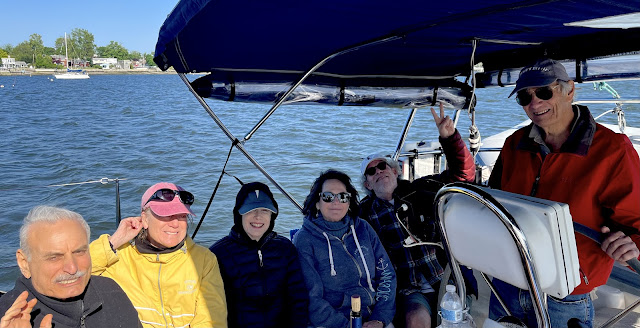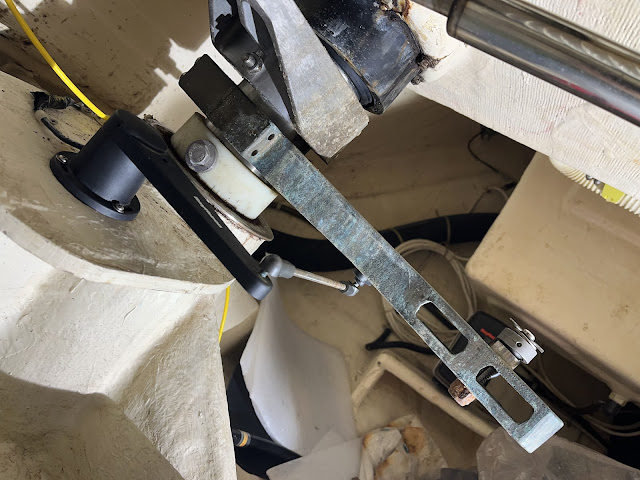I call them liveaboard nights because the days were spent ashore, filled with lots of errands and efforts to get ready to cast off from our home anchorage. Gas station, Home Depot, restaurants for lunches, supermarkets, bank, wine store, dry cleaner, dentist, shoe store, Costco for hearing aids, mailbox for Mail, Opthalmologist, MRI, auto parts store to obtain power steering fluid which stopped a squeak that har emerged while driving, our apartment to pick up 17 items we had forgotten which Lene had listed, and, last but not least, four hours in the Emergency Room which determined that Lene’s chest pains had no cardiopulmonary implications.
I enjoyed my book group’s meeting and dinner at a friend’s house one night and took the dink in to the dock that night to permit my midnight return. In that regard ILENE’s anchor light was turned on by Lene, making her the only lighted boat in the field and easy to find. I noticed, in passing, that four us ten men in the book group are current or past owner/captains of cruising sailboats. And the book selected for our October meeting is “The Wager” a documented historical account of the shipwreck, survival and mutiny of the crew of The Wager, a British warship off Chile 1740’s. We also passed a pleasant afternoon and evening in outer Brooklyn with Lene’s brother, Ken, and nephew, Mendy. We sadly had to adjourn a dinner with David and Chris, due to Lene’s visit to the ER. And, weather permitting, we have sailing dates each day of the imminent holiday weekend.
The biggest mechanical headaches involved fresh water and not all of them are solved. A leak from the faucet of the galley sink was permitting water to escape onto and below the counter. My biggest obstacle was how to unscrew and remove the 25 year old faucet. I would have to unscrew large black plastic nuts from the bottom of the counter which had been screwed tight to secure the fixture to the top of the counter and probably corroded there. I could not imagine the tool which would permit this in such a cramped space. At Home Depot we realized that we needed a plumber! Out in its parking lot, readying to leave, a panel truck drove up with our answer on its side: “PLUMBER handyman - reasonable rates”. Lene hailed the driver, Jose, and perhaps ten texts later he had agreed to come to the Harlem launch at 8 a.m. the next day. We purchased the new faucet he suggested and we’re happy about the good fortune of our serendipitous find. That evening he changed his arrival to “8 to 9”, which was fine. But by ten thirty he had not come or responded to texts or calls so we selected another plumber who arrived at 12:30. He carried an electric grinding wheel which he used as a saw, to cut off the top of the old faucet, pry up the cover plate and push the old bottoms down through the holes through in the counter. I had never thought of that. But after cleaning the mess we saw that the two large black plastic tubes of the new fixture had a slightly larger diameter and would not fit through the holes. I knew what to do and offered my electric drill with its largest bit. He used the sides of the bit to grind the holes to a larger diameter until the tubes fit. But then problem two: the old fixture had short copper pipes running down which were fit into the plastic hoses bringing water up from the tank, and secured with hose clamps. The new fixture had longer hard plastic tubes of a slightly thinner outside diameter with fittings at the ends, to be secured to I wonder what? My solution: cut the plastic tubes to the right length, use wraps of my black electrical tape to make their outside diameters bigger, jam them into the rubber hoses and secure them with the hose clamps. “It’s not orthodox” he said, but he did it, and it is not leaking. Jim, retired Captain of the sailing vessel “Aria”, cautioned me that hot water could affect the tape and hence to periodically check, which I will do.
But other fresh water problems: the o-ring in the water maker’s carbon filter (to extract chlorine from the ship’s fresh water used to flush the water maker, was loose, causing fresh water to flow out and fill a lot of the bilge. I hope I have successfully reseated the ring but the new (as of last spring) electronic-monitoring bilge pump was not working so I had to use the hand bilge pump. This might be a fuse problem. We ran out of water in the port fresh water tank, the only one I filled, necessitating a short hop to the nearby City Island YC to refill. They have deep enough water at their dock, regardless of tide We could not go to the Harlem’s dock to water, usually available for five hours at each high tide, because the extra, low, aluminum dock used by the friendly, cheerful and generous Fordham Women’s Crew Team, is using that space until their season ends next week. And now it appears that the electric fresh water pump that draws water from the tanks to the faucets is not working. Always something to try to figure out and fix, but the supply of time until June 1 is running low.
And little boat chores too: (1) removing a 2 x 6 lashed to the stanchions (to be replaced with a longer 2 x 8, currently in the locker) to serve as a fender board, to be hung outboard of a pair of fenders, to protect ILENE’s sides from docks sided by rough pilings, (2) realigning the primary (green) and new secondary (red) jib sheets to place the former high on the sail’s clew, above the latter, and thereby prevent the thin red lines from getting caught up in the block of the green line and (3) rigging a way to hang the dinghy from the halyard, above the water along ILENE’s port side.
Some photos: sorry I can’t integrate them to the paragraphs of text.






















